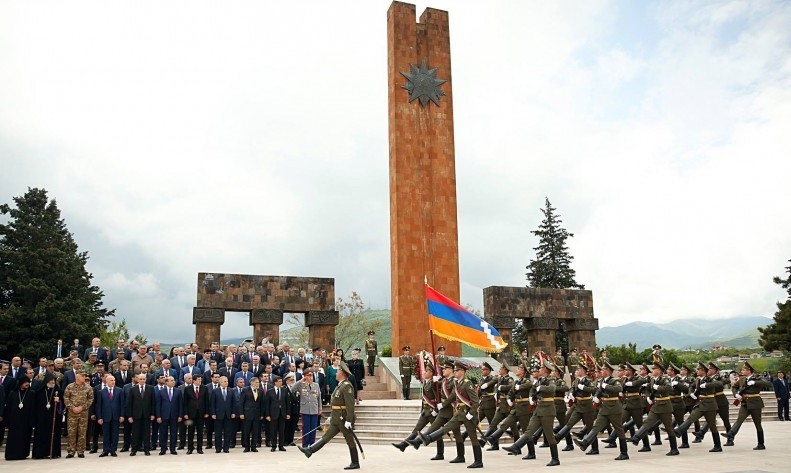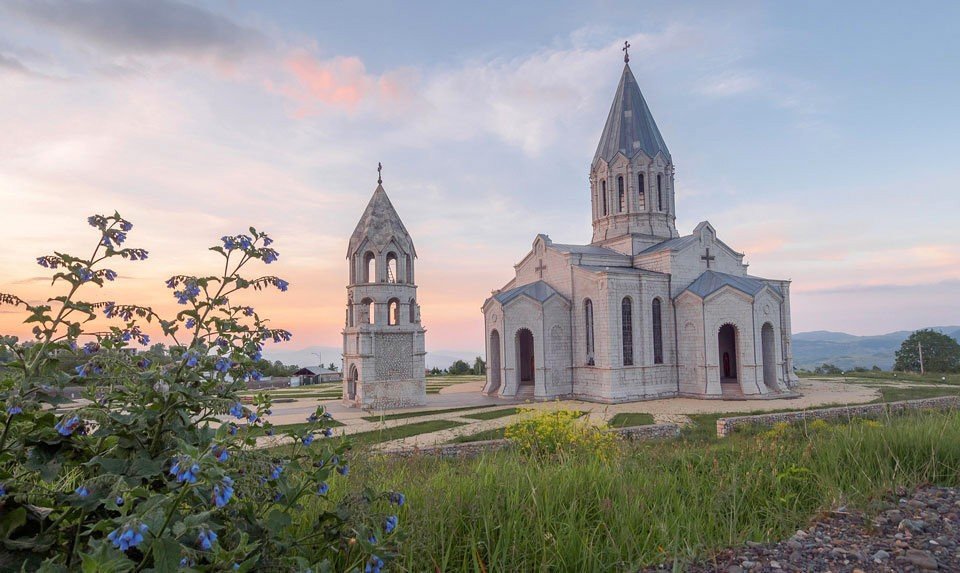The history of Armenia is full of heroic deeds. Two of the victories – the liberation of Shushi and the victory in the Great Patriotic War, are celebrated on May 9 for years. The fortress of Shushi was the administrative, religious, educational and cultural center of Artsakh until 1920. It was one of the 15 states of ancient Armenia. By the liberation of Shushi, Artsakh (also known as the Nagorno-Karabakh Republic), was declared as an unrecognized state.
The commanders carried out the battle from the 4 fronts. They put the glorious end to the military operation named “Wedding in the Mountains”. The fighters entered Shushi on May 9. Shushi had historically been the capital of Artsakh. The word Shusha derives from the word “Shosh” which in the Artsakh dialect means “the highest sprout of the tree”. Thus people named the city ”Shushi” because of its high geographical position.
Background
Armenians celebrate Victory and Peace Day on the 9th of May every year. It is a fixed day to celebrate the liberation of Shusha of May 1945 and the end of the Second World War in Europe.
The battle of the Liberation of Shusha began on the evening of May 8, 1992. It was a turning point in the Artsakh war. The battle continued until the next day. On May 9 Armenian forces liberated Shusha and drove out the defending Azeris. Armenian military leaders were in Nagorno-Karabakh’s capital. They had been thinking about the plan for the liberation of Shushi after Azeri bombarding of Stepanakert.
During the Nagorno-Karabakh War, it was the first notable military victory by Armenian forces. The Armenian leaders named the plan “Wedding in the Mountains”. It is important to realize that Shusha had a good location for seizing Artsakh. The loss of Shusha led to a numerous of military victories by Armenian forces in the course of the conflict. Unfortunately, the opposite side intentionally bombarded at ordinary citizens.
Armenians use ”the Capture of Shusha” as the Liberation of Shushi while Azerbaijanis use it as the Occupation of Shusha.
Nagorno-Karabakh several years had been in the borders of the Azeri SSR. Soon the government decided to separate it from Azerbaijan and join it with Armenia. After this decision, the disagreement began and turned into a massive ethnic enmity between Armenians and Azeri people living in the Soviet Union.
The Beginning
After the Soviet Union falling in 1991, these two countries began taking control of Karabakh with large battles in the winter of 1992. After that, the region had declared its independence. Up to the present time, Azeris hadn’t recognized its self-determination.
As a matter of facts, both sides used advanced weaponry of tanks, armored fighting vehicles, fighter jets and helicopter gunships. When the conflict began, it affected the population and soon many Armenians living in Azerbaijan flee to Armenia and the Azerbaijanis living in Armenia went back to Azerbaijan. Armenians seized the town and captured the only airport in Khojaly in February 1992. By losing Khojaly, Azeri leaders focused the rest of their fires upon Stepanakert.
Shortly afterward, on 26 January, the Azeri people placed their forces in Shusha and bombarded nearby Armenian village named Karintak. The village is located on the way from Shusha to Stepanakert. So they wanted to capture it. The leader of this operation was their defense minister Tajedin Mekhtiev. In this way, Tajedin wanted to create a basis for the future attack on Stepanakert.
The plan failed as the villagers and the Armenian fighters reacted and hit back. Armenians set an ambush for them and this resulted in the death of up to seventy Azeri soldiers. After this failure, defense minister left Shusha. For Armenians; it was one of their early and most decisive victories.
The Course of Action
Shusha is in the disputed region of Nagorno-Karabakh in the South Caucasus. The town is four miles to the south of Stepanakert. From a geographical point, Shusha was the convenient area for Azerbaijani to bombard Stepanakert. The principal kind of artillery used in firing was the Soviet-made BM-21 GRAD multiple rocket launcher. The usage of it began on January 10, 1992. This artillery was capable to fire 40 rockets in one salvo.
Thia launcher had the resemblance with the World War II-era Katyusha. It did not have a guided rocket system and so it was difficult to know the location of where it would hit. In fact, the weapons used here caused huge injury to buildings. The damage comprised the residential houses, schools, the factory, and hospital.
Shusha was the main fire point from where the opposite side attacked Stepanakert. The city had 70,000 populations. The battle forced nearly 20,000 of Stepanakert’s residents to drive away and the remainders lived in basement floors.
In early April, 157 rockets had arrived on the city in a day. By early 1992 the firing strengthened. During one week the city was fired with over 1,000 shells. On February, Russia sent ten servicemen to maintain peace between the Armenians and Azeri people. Unfortunately, because of the fires, they were injured and one of them was killed in a firing by artillery. Because of the shelling, more than 2,000 civilians were killed and thousands more injured in 1992. Moreover, the infrastructure of the city was completely damaged. In an article published in April 1992, it was noted that only one building escaped damage in Stepanakert. According to the facts, Azeri people also launched air raids.
The Battle
The plan of the Armenian army was under the patronage of Colonel-General Gurgen Dalibaltayan. He was guided by Arkady Ter-Tadevosyan. As a matter of facts, all of the factors were in favor of the Azeri Army. Obviously, the advantage referred to the quantity and the quality of equipment used in the battle. Must be remembered that Azeri Army had many advantages. Because of its geographical position Azeri Army could easily capture the area. Hence, a direct attack by Armenian forces was not the right option.
In fact, according to military conventions and practices, the operation is successful if the attacking party outnumbers the defenders by at least 3 – 4 times. Irrespective of these facts Armenians made the plan still not having enough number of people and power at the time. Armenian Army planned to launch several diversionary attacks to draw the opposite side. Arkady “Komandos” Ter-Tadevosyan guided all of the attacks.
Order of Battle
The Armenians finalized the plan in March – April 1992. The leaders signed it on May 4, 1992. The plan included various steps; the soldiers should defeat the enemy from Stepanakert side at three Shushi sides. After that, they should then to eliminate the enemy and release Shushi.
Before the offensive, Ter-Tadevosyan’s forces launched an artillery barrage from several directions to mitigate the town’s defenses. The attack was to start on May 4, but because of the lack of the weapons and weather conditions, it launched on May 8.
The Offensive and Victory
On May 8, Ter-Tadevosyan led his forces to attack Shusha from different sides. The team was divided into 5 parts, four of which would attack from different directions. These teams were led by Arkady Karapetyan, Valery Chitchyan, Samvel Babayan and Seyran Ohanyan. The fifth one was the support team. They should help if any of the groups would need quick amplification. Yura Ovanisyan controlled this team.
Meanwhile, the Azeri commander was Elbrus Orujev. He led a group of several hundred men and tanks. Orujev’s men fought with Chechen volunteers led by Shamil Basayev. By mid-day, the fighting turned into a full-scale engagement. An Armenian T-72 tank entered to Shusha and met Azeri people on the northern side of the town.
Soon Azeri people began firing on the tank. They hit the Armenian tank, directed by Gagik Avsharyan, and broke it down. Armenian tank was too old and ineffective against the other tank.
Thus, two of the tank’s team members were dead and only Avsharyan survived. In the evening of May 8, Armenian fighters eliminated three of the GRAD launchers. By May 9 the Armenian forces were in control of the town. Azeris had turned Ghazanchetsots Cathedral into storage for the GRAD weapons. The attack was too powerful and Orujev ordered his army to abandon the citadel. After the capture of the town, many people came to the city for plundering.
Political Fallout
After the offensive, Armenian forces began an attack in the region of Lachin and hence opened up a five-mile corridor. The attack prompted two attacks by Azeri forces. Azeri forces did attacks but their attempts had failed. From the Armenian Martuni front, Armenian forces could keep the territory by having numerous losses.
On the day of the Armenian victory, Armenian and Azerbaijani presidents were present in Tehran, Iran to sign a cease-fire agreement. Mamedov used the news of the Armenian offensive to charge Armenia for failing to honor the cease-fire. However, Armenian President told that he was unable to control what the Armenians were planning in Karabakh.
The loss of town forced Azeri people to demonstrate in Azerbaijan’s capital of Baku. They charged the new president for failing to capture this territory. After the battle, Armenians repaired Avsharyan’s T-72 tank. Nowadays it stands as a monument in Shusha.
Presently, May 9 is now celebrated in Armenia and the Nagorno-Karabakh Republic as “The Day of the NKR’s Defence Army” and “The Day of Liberation of Shushi”. The government awarded medals to those Armenians who took part in the battle. The city developed since the war ended in 1994. In fact, Turkish army supplied Azerbaijan with arms and military equipment. Turkey was engaged in the promotion of Azerbaijani conflict resolution efforts.
Results of Shushi Liberation
Due to the excellent fulfillment, up to the present time, Shushi operation ( Wedding in the Mountains) become the subject of admiration of military experts. The liberation of Shushi was very important for all Armenians. The victory showed the Armenian people unity and power.
In conclusion, the people who died during the battles for Shushi Liberation comprises of 57 fighters from Armenia and 250-300 people of Azeri, 700 Armenians were injured and 13 of them were missed in action.














Leave a Comment